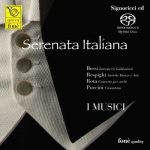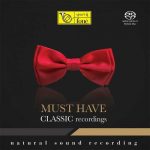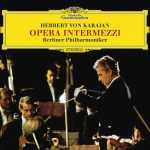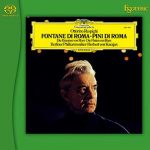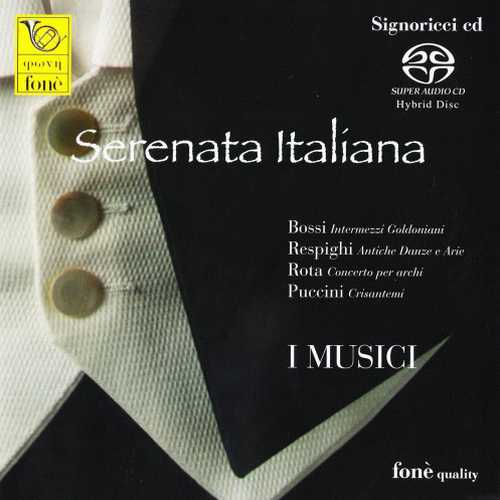
Composer: Marco Enrico Bossi, Ottorino Respighi, Nino Rota, Giacomo Puccini
Performer: I Musici
Format: DSD64 (ISO)
Label: Fone
Release: 2009
Size: 2.56 GB
Recovery: +3%
Scan: yes
Marco Enrico Bossi:
Intermezzi Goldoniani op. 127
01. 1. Preludio e Minuetto
02. 2. Gagliarda
03. 3 .Coprifuoco
04. 4. Minuetto e musetta
05. 5. Serenatina
06. 6. Burlesca
Ottorino Respighi:
Antiche Danze ed Arie per liuto, Terza Suite per archi
07. 1. Ignoto: Italiana (fine del sec. XVI)
08. 2. Giov. Batt. Besardo: Aria di Corte (sec. XVI)
09. 3. Ignoto: Siciliana (fine del sec. XVI)
10. 4. Lodovico Roncalli: Passacaglia (1692)
Nino Rota:
Concerto per archi
11. 1. Preludio e Minuetto
12. 2. Scherzo
13. 3. Aria
14. 4. Finale
Giacomo Puccini:
Crisantemi
15. Crisantemi
Italian audiophile label Fonè celebrate the 57th Anniversary of the legendary string group I Musici with this new straight to DSD recording (albeit unfathomably only in 2ch). Many of my generation will have made their 1st encounters with Baroque music from I Musici’s huge recording catalogue, & they also brought more contemporary composers such as Bartók, Britten, Hindemith, Martin & Rota to our attention. Eventually their long association with Philips fell prey to the collapse of the recording industry & their recordings were in competition with the burgeoning period orchestras & ‘historically aware’ performances.
Nevertheless, the group are still thriving, despite many changes in personnel. There are always some veteran members to pass on the tradition to new members of the group, ensuring that their reputation for a warm Italianate sound, tight ensemble & individual virtuosity is maintained. The present group, a democracy eschewing conductors, boasts 5 violins, 2 violas, 2 cellos & double bass; they play fine old instruments including several by N. Amati.
Recording engineer Giulio Cesare Ricci placed the group on the stage of a theatre with a fairly simple array of Neumann valve U47, U48 & M49 microphones, passing the signal through Signoricci preamps & cables to a Pyramix recorder with dCS convertors to DSD. Regrettably, however, the theatre is very dry & almost no ambience is captured (perhaps a Mch set-up here would have helped). The result is that the instruments sound very close & lack sweetness & bloom, although their individual timbres are captured in detail. Furthermore, above the stave the violin sound is hard & somewhat aggressive at fortissimo, not what we expect to hear from the valve microphones. This effect is rather exaggerated by the relatively high transfer to disc, which caused me to rapidly back off my volume control the moment the music started. Interestingly, the fierce treble sounds are mostly tamed on the CD layer, although the overall sound is more grainy. I much prefer the bloom & air which Philips engineers consistently gave to I Musici.
I Musici’s attractive programme reflects both their past & current repertoire, under the general banner of Serenata Italiana. This was my 1st encounter with Marco Enrico Bossi (1861–1925), a late Romantic & premier organist of his time, who established a training scheme for organists which is still in use today. His compositions included orchestral & chamber music, & his Intermezzi Goldoniani Op. 127 recorded here is a real find. It is a rather whimsical suite of dances (& the odd march) which provide a kaleidoscope of melody & textures which allow I Musici to show off their talents most entertainingly & wittily. Respighi’s romanticised settings of ancient lute airs & dances are very well known, the 3rd Suite being almost a signature piece for I Musici, & they give it a fine performance; lilting, tender & passionate in turn.
Nino Rota is perhaps best known for writing the music for Fellini films, but he composed his ‘Concerto for Strings’ for I Musici in 1964, & dedicated it to them. It is perhaps a slighter piece of this genre than those by say, Tippett or Baciewicz, but its mixture of Romantic & more modern styles (with nods towards Stravinsky) are very effective, & again show off the group’s interpretative & technical skills.
The concert ends with Puccini’s lovely & sentimental Crisantemi (Chrysanthemums), an elegy for string quartet penned in 1890. The music was used again in the finale of Manon.
If you are interested in hearing the present-day I Musici in this repertoire, the performances are excellent. Despite the dry sound, their artistry shines through, & the bright upper partials can mostly be tamed with judicious use of one’s volume control.
